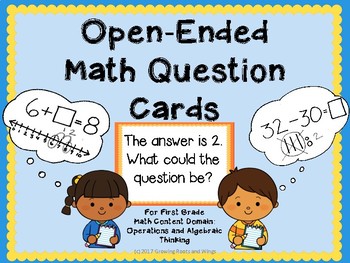Open Ended Math Questions-Operations and Algebraic Thinking-First Grade
Growing Roots and Wings
138 Followers
Grade Levels
1st
Subjects
Resource Type
Standards
CCSS1.OA.A.1
CCSS1.OA.A.2
CCSS1.OA.B.3
CCSS1.OA.B.4
CCSS1.OA.C.5
Formats Included
- PDF
Pages
22 pages
Growing Roots and Wings
138 Followers
Description
This download includes:
72 Question Cards with 2 questions per card (144 questions!)
A kid-friendly self-assessment checklist.
Benefits:
Open-ended math questions promote critical thinking, flexibility, perseverance and creative problem solving. Students have multiple ways to respond, so you can reach students with varied learning styles. These cards require students to choose which prompt they will respond to which boosts engagement and offers an additional layer of differentiation.
Suggestions for Use:
Print on card stock, cut and laminate.
Use whole class as a warm up or to introduce a lesson, in small groups to reteach or enrich, in partnerships to promote math talk, for fast finishers, or as a math center.
Students can write their responses on paper, in math journals, on dry erase boards or work mats. I have also had students work in partnerships and quads and share their responses verbally using the “Think, Pair, Share” discussion strategy.
72 Question Cards with 2 questions per card (144 questions!)
A kid-friendly self-assessment checklist.
Benefits:
Open-ended math questions promote critical thinking, flexibility, perseverance and creative problem solving. Students have multiple ways to respond, so you can reach students with varied learning styles. These cards require students to choose which prompt they will respond to which boosts engagement and offers an additional layer of differentiation.
Suggestions for Use:
Print on card stock, cut and laminate.
Use whole class as a warm up or to introduce a lesson, in small groups to reteach or enrich, in partnerships to promote math talk, for fast finishers, or as a math center.
Students can write their responses on paper, in math journals, on dry erase boards or work mats. I have also had students work in partnerships and quads and share their responses verbally using the “Think, Pair, Share” discussion strategy.
Total Pages
22 pages
Answer Key
N/A
Teaching Duration
N/A
Last updated Aug 1st, 2017
Report this resource to TPT
Reported resources will be reviewed by our team. Report this resource to let us know if this resource violates TPT’s content guidelines.
Standards
to see state-specific standards (only available in the US).
CCSS1.OA.A.1
Use addition and subtraction within 20 to solve word problems involving situations of adding to, taking from, putting together, taking apart, and comparing, with unknowns in all positions, e.g., by using objects, drawings, and equations with a symbol for the unknown number to represent the problem.
CCSS1.OA.A.2
Solve word problems that call for addition of three whole numbers whose sum is less than or equal to 20, e.g., by using objects, drawings, and equations with a symbol for the unknown number to represent the problem.
CCSS1.OA.B.3
Apply properties of operations as strategies to add and subtract. If 8 + 3 = 11 is known, then 3 + 8 = 11 is also known. (Commutative property of addition.) To add 2 + 6 + 4, the second two numbers can be added to make a ten, so 2 + 6 + 4 = 2 + 10 = 12. (Associative property of addition.)
CCSS1.OA.B.4
Understand subtraction as an unknown-addend problem. For example, subtract 10 – 8 by finding the number that makes 10 when added to 8.
CCSS1.OA.C.5
Relate counting to addition and subtraction (e.g., by counting on 2 to add 2).





